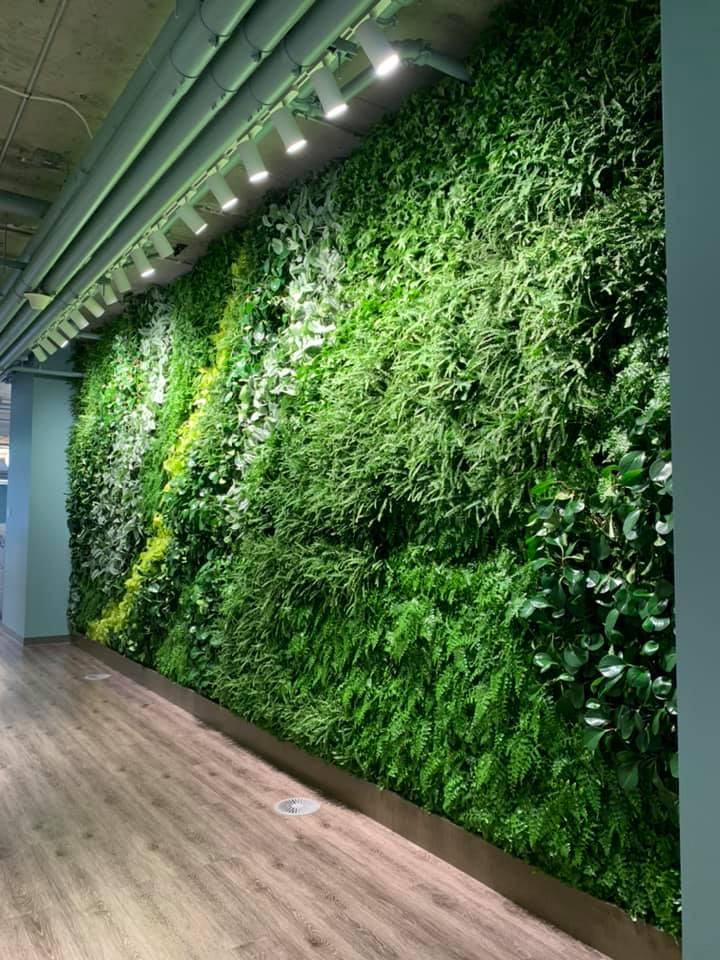
Our latest living wall installation, a project in Los Angeles. Photo: Good Earth Plant Company
Some people call them green walls, others call them plant walls or live walls, and we also hear them called vertical gardens. Some versions are edible walls. Some are inside, some are outside. Good Earth Plant Company refers to these beautiful displays of nature by their most common name: living walls.
We recently attempted to count the number of living walls we’ve installed over the past 15 years. We stopped counting at 200. They range in size from small items that resemble traditional works of art to living walls on a massive scale. Our tallest? The living wall on the exterior of the Loews Santa Monica Hotel (80 feet). Our largest? Outdoors, it’s the living wall on the north side of the Fashion Valley Mall, across from the Cheesecake Factory. Inside, it’s the living wall in the lobby at 655 West Broadway in downtown San Diego.
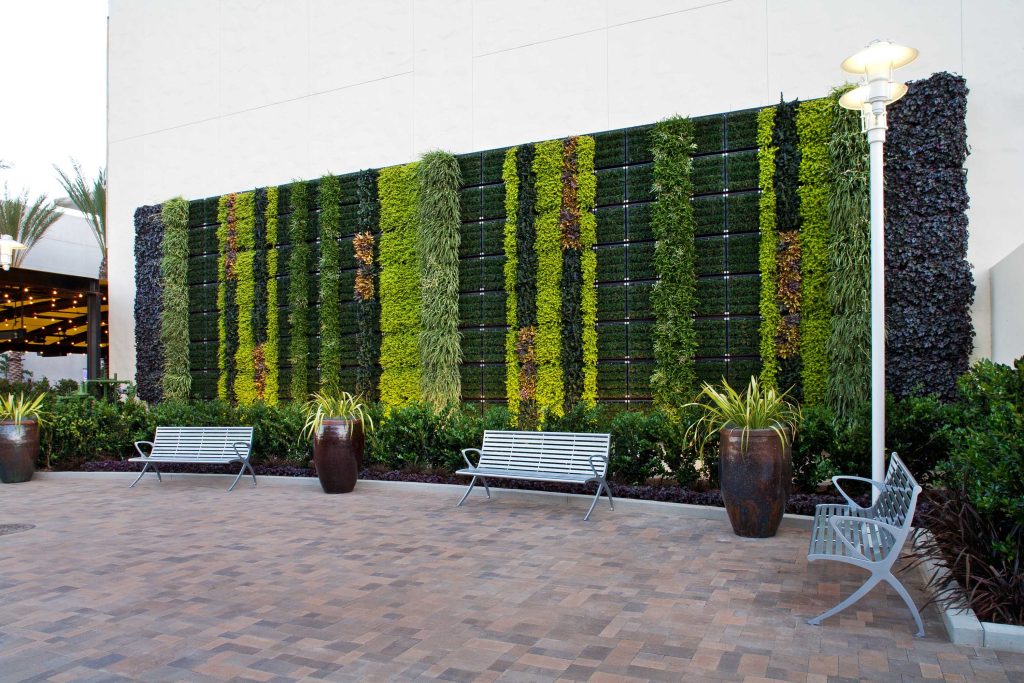
Our largest living wall is one of our oldest, installed at the Fashion Valley mall.
Human beings have been growing plants on walls for centuries. One of the Seven Wonders of the Ancient World is a living wall: the Hanging Gardens of Babylon. Today’s living walls keep getting more popular, more creative, and also more sophisticated from a design and construction perspective. Improvements in technology benefit living walls just like many other products.
We love answering questions about living walls. We thought it would be an excellent time to review the basics and tell you about several new methods of construction Good Earth Plant Company offers. We’re enthusiastic about the latest innovations available for our clients.
Living Wall Class is In Session
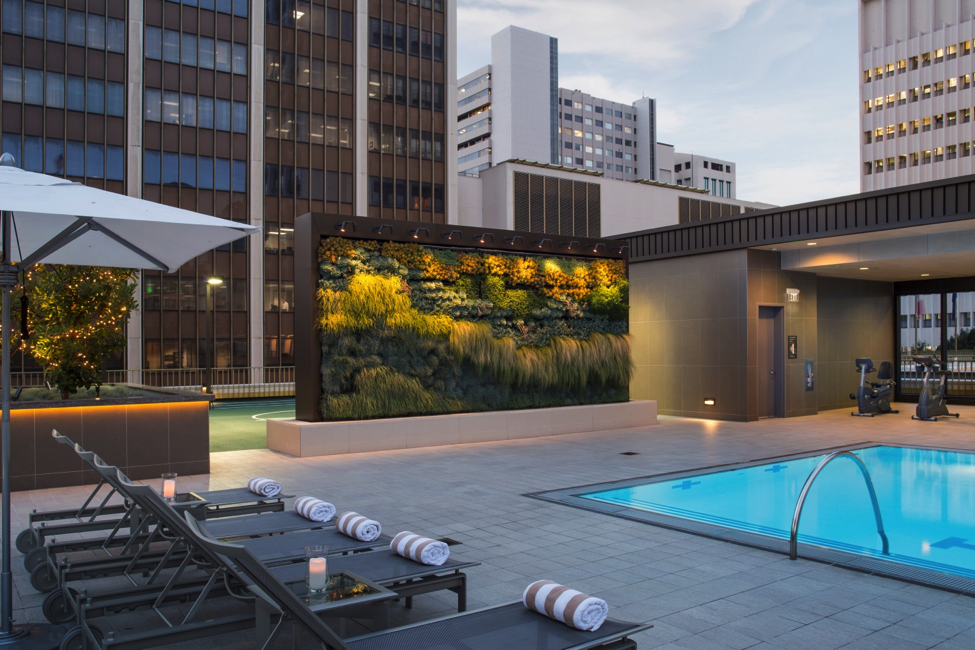
One of our most spectacular projects atop the Westgate Hotel.
While vines like ivy growing up a wall itself is a living wall, the version we work with uses an engineered framework, holding containers for plants to root themselves into a growing medium in this independent structure. The structure itself can be attached to an existing wall of a building both inside and outside. It can also stand alone in an independent structure – like the living wall we created for the Westgate Hotel’s rooftop. We typically prefer not to attach a living wall to a fence.
Although many systems don’t require it, complex living walls systems include two additional elements along with the growing media, plants, and structural support – an integrated irrigation system and a drainage system.
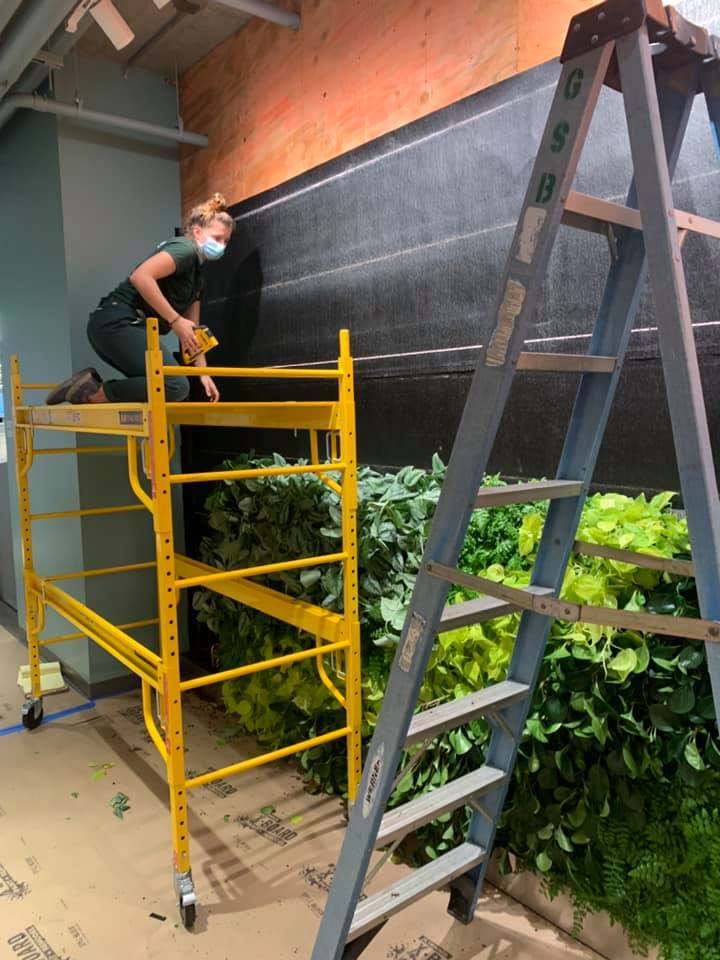
Weslea Greyson works on the installation of a living wall. Photo: Good Earth Plant Company
There are several good choices in living wall systems themselves. We look at the location, lighting conditions, temperature and humidity, the building and structure we’re working with, the type of plants, and the finished look the client wants. We also talk with clients about maintenance. It’s a little like hairstyles. Some people want wash and wear, and maybe an occasional trim. Others spend a lot of effort on complex cuts, color, and need a lot of styling and maintenance. When we refer to ourselves as plant stylists, there’s a reason!
Maintenance is key to long-term success. Good Earth Plant Company won’t install a living wall without a minimum of a one-year maintenance contract. And we’ll continue to care for it forever.
Simple Living Wall Systems
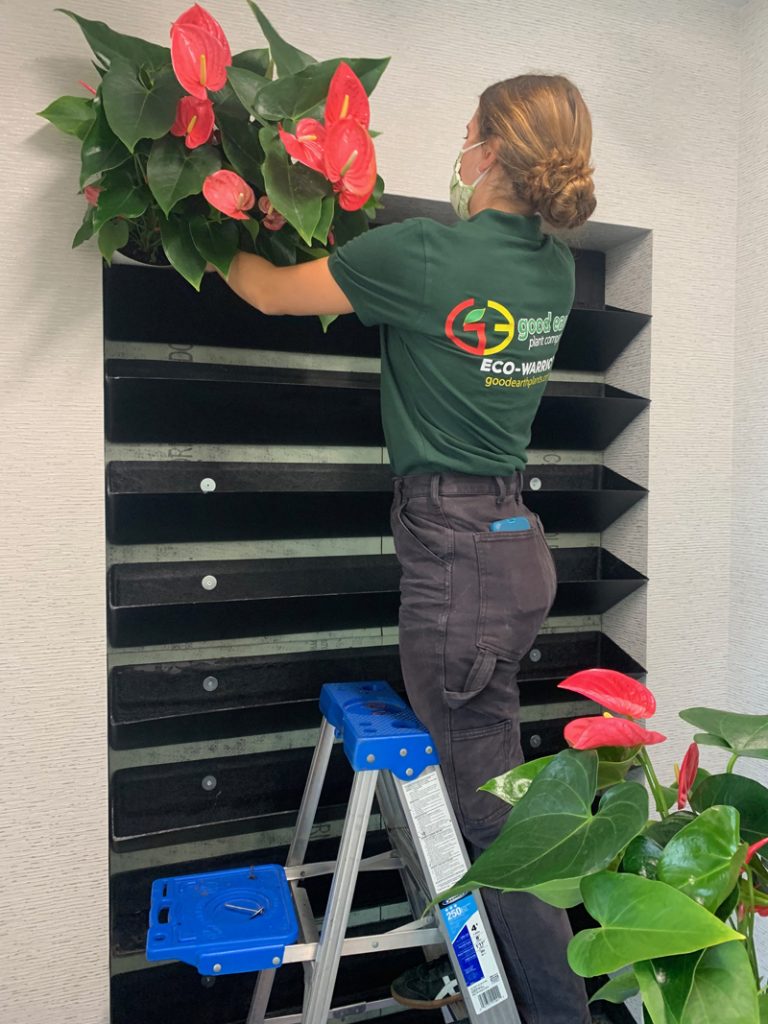
A look at the construction of a simple living wall system that holds container plants. The plants can be swapped out easily to change the design. Photo: Good Earth Plant Company
The simplest living walls are stand-alone, smaller structures with pockets, trays, or slots. You might even see these sold on home furnishing company websites. They’re similar to planters you might use in your yard or house, with holders for containers instead of shelves. The plants aren’t actually planted within the wall systems.
When we work with larger residential or commercial walls, it’s possible to set up these pocket-type systems. Container plants already growing in their pots sit in them. We have clients who like to switch out plants depending on the season, making it easy to do. We have one of these simple systems in the lobby at Good Earth Plant Company World Headquarters. Watering requires a drip irrigation system or good old-fashioned hand watering.
Living Walls Built To Last
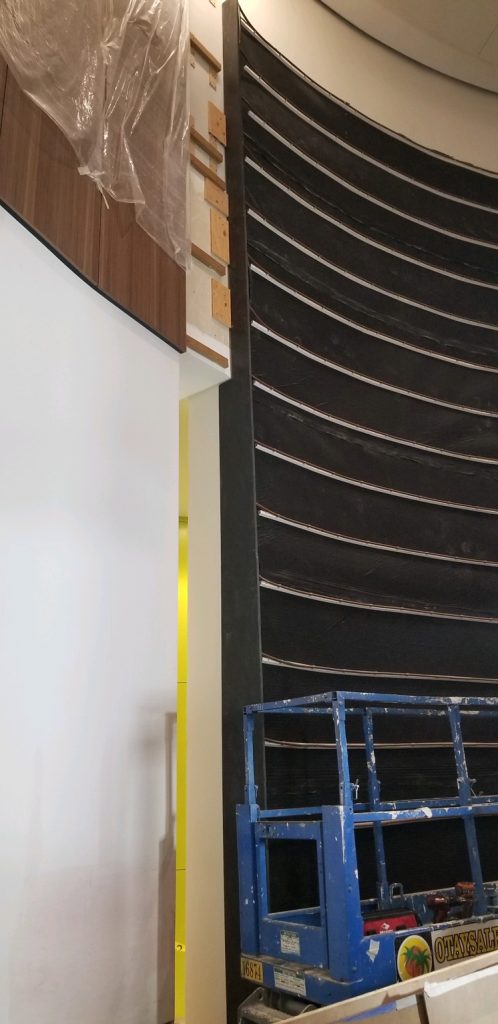
The 655 West Broadway project is the first convex curved living wall Good Earth Plant Company has installed, and only the second curved living wall overall. Photo: Good Earth Plant Company
The next step is a living wall constructed using a heavy-duty framing system that requires engineering expertise to ensure the infrastructure is available to safely hold up the wall, including plants and water. One gallon of water weighs eight pounds. Living walls can weigh from five to 20 pounds per square foot.
Our award-winning living wall in the lobby in the Avison Young building at 655 West Broadway in San Diego is an excellent example of the approach for a large, complex living wall. The 300 square foot wall was constructed with a steel frame, attached to an existing wall. The frame holds 105 individual SageLife biotiles, modules filled with rock wool substrate. There are 1,972 plants and eight different plant species, including Dracaena warnekii, Neon pothos, Ferns, Compacta, Schefflera Arboricola, and Cordatum philodendron.
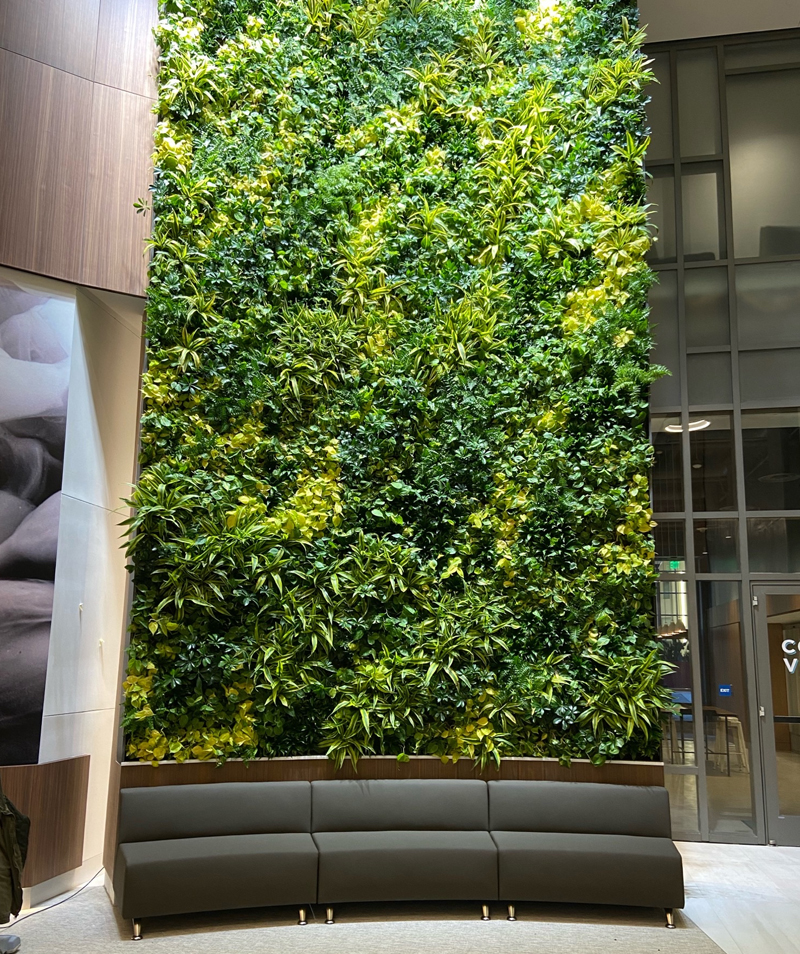
The completed living wall. It is 300 square feet, and 27 feet high – the highest living wall in San Diego County. Photo: Good Earth Plant Company
The irrigation system includes a fertilizer injector added to the water. A remote moisture monitoring system provides a convenient way to ensure plants are getting the right amount of water. We can see how much water the wall is using and can turn it on and off remotely. The entire wall uses approximately three ounces of water per square foot per day, or seven gallons daily.
This wall was our first ever convex curved wall and just our second overall. Working with flat surfaces is a lot less complicated.
Creative Customized Living Wall Designs
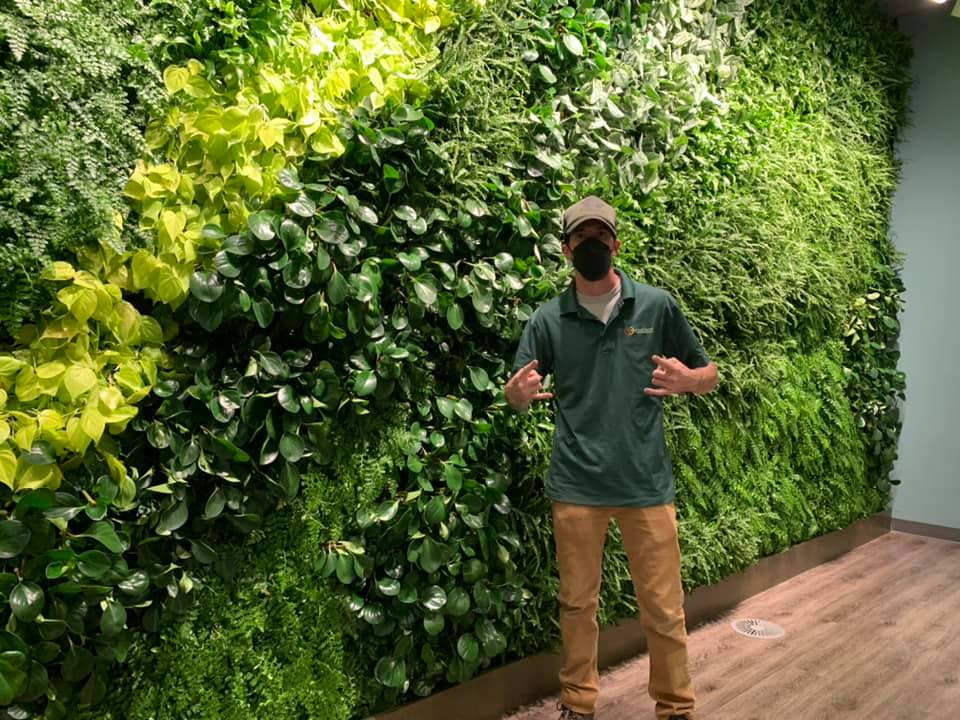
Rock on, Joe! Joe Benedetti shows off a newly installed living wall. Photo: Good Earth Plant Company
A more recent example shows off a system we co-developed with former employee Kevin Norton. It benefits from years of experience and troubleshooting. Any system can work when the conditions are ideal. But we work with reality! The plant modules are pre-grown with our nursery partners like Olive Hill (thank you, Denise!). This project also demonstrates the importance of lighting. Plants need at minimum light and water to grow. You might be surprised how many clients forget about this.
Sometimes even flat surfaces demand creative solutions. But we never imagined turning to 3D printing!
A client in the music industry had a specific idea about what he wanted in his home: the look of ferns filling a corner wall area inside his Malibu home. At first, designer Rachel Hecathorn found an off-the-shelf corner planter online that might fit the space. But it didn’t provide the look the client wanted, “and it definitely wouldn’t accommodate ferns,” said Rachel. She next went to a plastics company to see if it could help. After several discussions, it couldn’t provide the right shape or guarantee it was watertight.
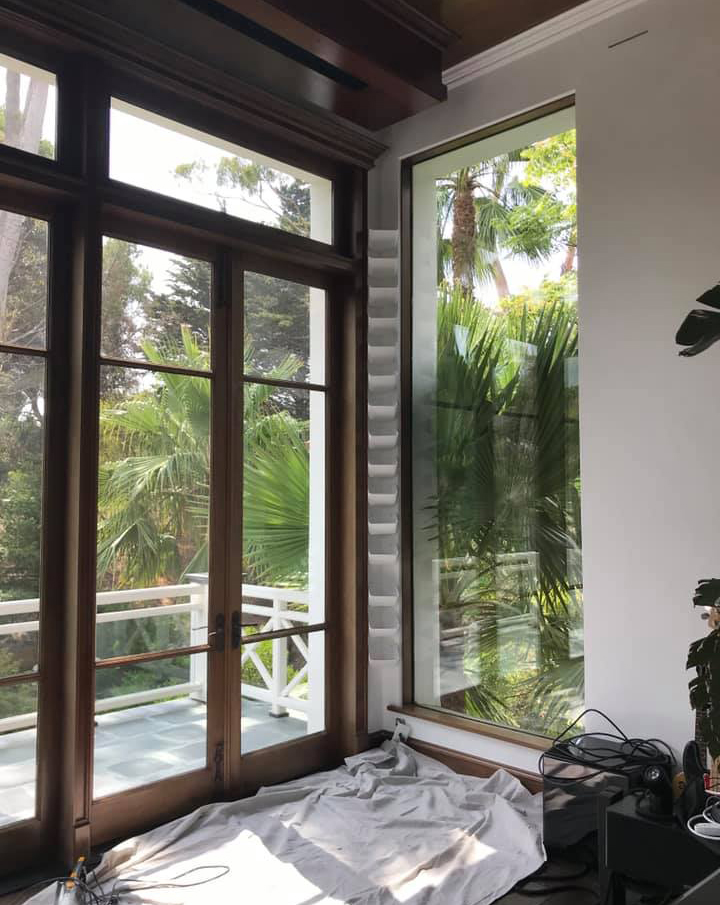
The 13 modules making up the plant containers in place in the wall.
Salesman Dan Summers found another source that could create suitable planters with its 3D printer. Rachel worked with the new vendor to create a prototype and adjusted the design by one-quarter inch to fit into the space. This version was perfect. Twenty-six individual modules (13 per side) were printed, and the project was successfully installed in one (long) day.

The finished living wall project with all the ferns planted.
No matter the size, from a small interior living wall display to a massive exterior living wall on the side of a multistory building, installation is critical. It’s not bragging when I say the Good Earth Plant Company installation team is equal parts experienced, skilled, and creative. They carefully address any installation issues and ensure our client projects are structurally sound, safe, and secure. There are no shortcuts. This is not the kind of work where you can hire day laborers.
Irrigation systems are integrated to prevent any seepage or leaks. Water can do a lot of damage if it’s not managed correctly. There are multiple choices, but that’s for another blog post.
Want to see more? Visit our Portfolio page for photo albums of our living wall projects. We update it frequently, so bookmark and check back!
We bet you are saying, “I’d like to find out more!” It’s as easy as calling us at 858-576-9300 or emailing info@goodearthplants.com. Our mission is enriching peoples’ lives with plants. Let us enrich yours!
